By now you must have asked yourself: “And where are the famous giant tortoises?” Well, they have all been gathered up in only a few places across the archipelago. One of them is the Charles Darwin research centre in Puerto Ayora and they can also be found in a couple of other places in the wild that are fenced off and controlled. The main reason for all of this is the fact that they are endangered or rather on a verge of extinction. Like in the case of the ones from the Seychelles, it is not really known how such big land animals managed to migrate from the continent to these remote islands. Still, they did manage and liked it so much here that they developed specific characteristics on each island separately, earning them classification into sub-species. The main reason for their consistent annihilation was a practical one. As I’ve said, there are no fresh water sources on the Galapagos, but there is fresh tortoise meat which is said to be very tasty. In addition, the tortoises can survive a couple of months with no food and water, which made ships stop by and take tortoises “to go,” thus bringing them to the brink of aisaster. What little remained was further destroyed by rats, since they find tortoises’ eggs very yummy. Now, the Charles Darwin Research Station works on breeding tortoises firstly in order to move them away from that brink. Even so, there is an exceptionally sad example for all of this. He is called Lonesome George. Everybody calls him that. He is the last specimen of his sub-species that used to populate the island Pinta. The Station has tried to find a female of his kind all over the world’s zoos, but with no success. Cloning is far too unreliable and expensive, and has been given up. So, the Station tried some less expensive and traditionally more reliable methods – they got him two younger females of the closest sub-species and put them in the same enclosure with him. At the time I was on the Galapagos, Lonesome George was around 180 and was supposed to be still sexually active. However, even two younger babes could not inspire him, so no offspring has been produced. (By the way, since I posted this text, Lonesome George has sadly died without producing any successors). I should also say that Galapagos means “tortoises” in Spanish, which clearly shows how the islands got their name.
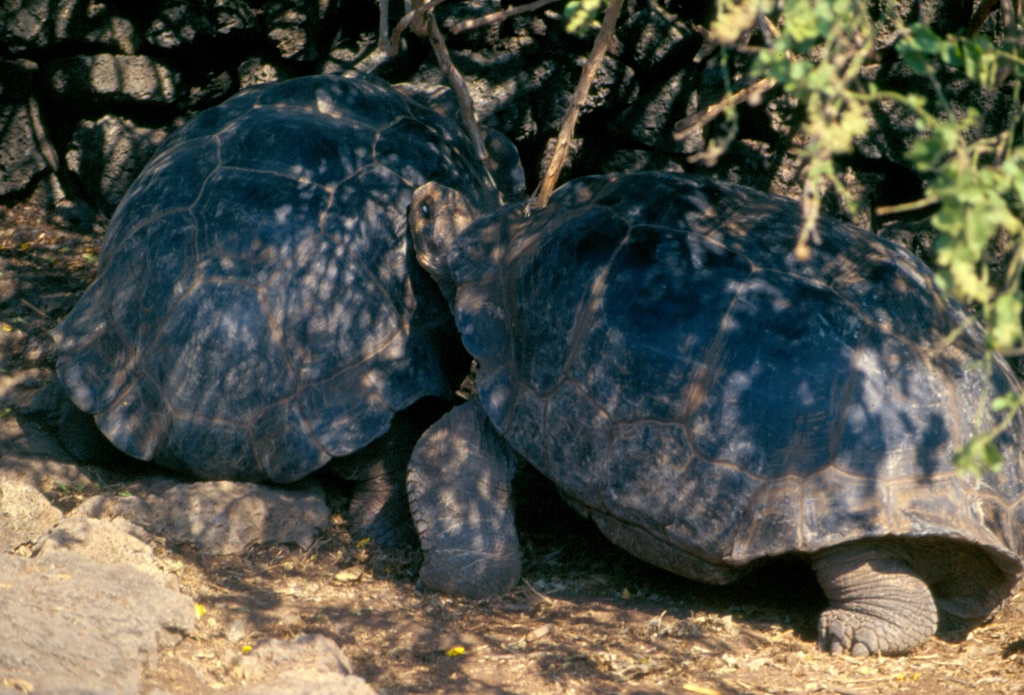 Giant tortoises
Giant tortoises
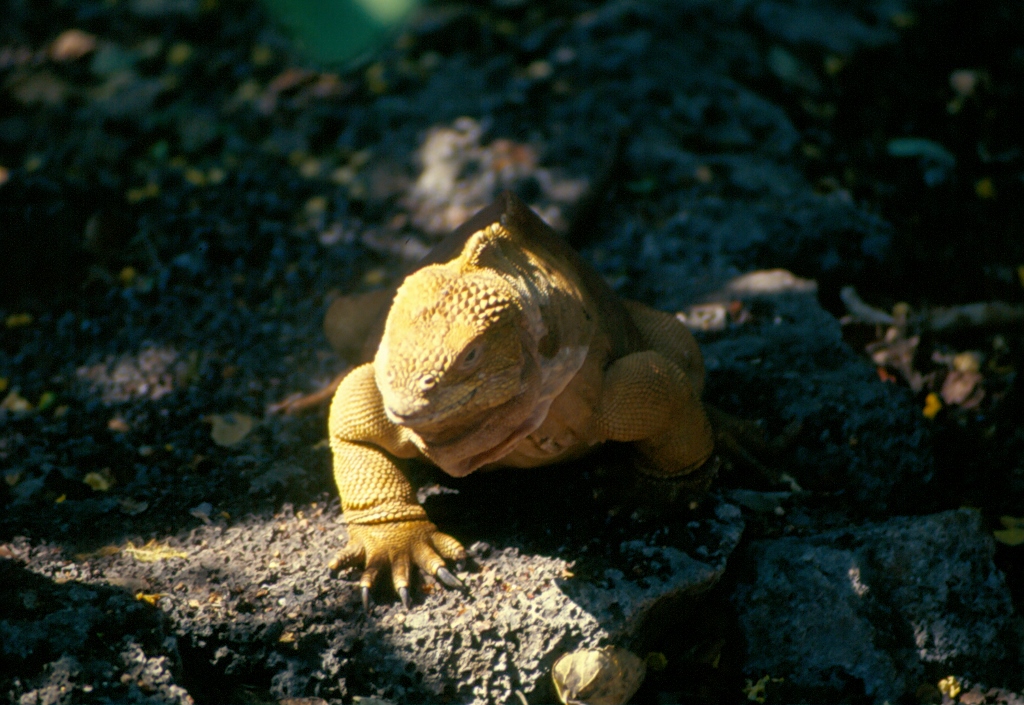 Land iguana
Land iguana
After a brief visit to tortoises and land iguanas that are also bred at the research centre, we had some free time which was enough to visit Puerto Ayora. It is a tiny coastal town, with some lovely parts, but it seemed to me perhaps too civilized and polished after those natural beauties I had been exposed to beforehand. Still, modern times have their perks, so I took full advantage of an internet cafe and satellite connections to get in touch with friends and family. In the afternoon we went to the hills of Santa Cruz and this was where we saw quite an abundance of greenery. The goal of our brief outing was a visit to the crater of a volcano that was active who knows when, since all of its sides were fully covered in shrubs and trees. Looking from the edge into the crater covered by dense vegetation it gave a clear picture of some lost world or remains of some ancient civilization that could be trapped within it. Of course, none of that was true, it was only my imagination, but the greenery, elevation and light breeze proved to be a fine respite. There was another lava tunnel nearby and with that we completed our touring of Puerto Ayora and its environs. The departure time was around midnight and I took up my place on the mattress in front of the cabin with the command deck.
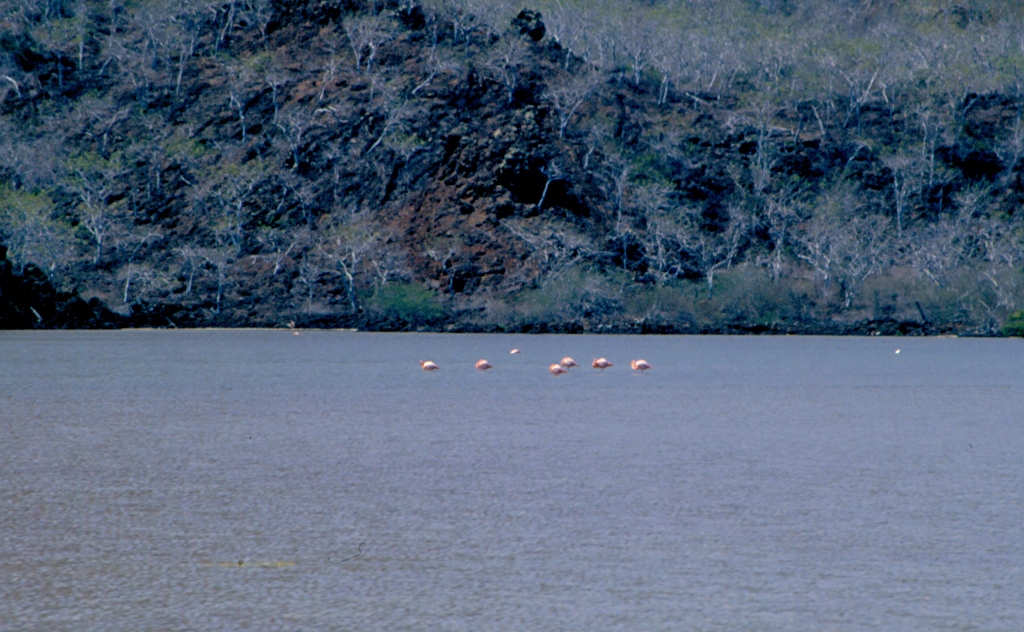 Flamingos
Flamingos
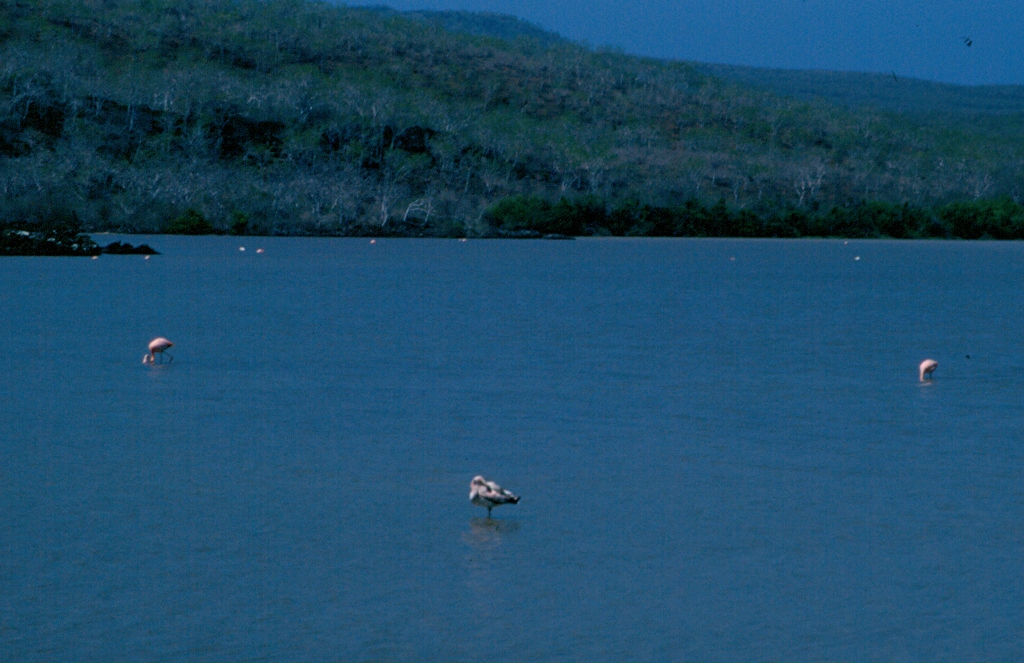 Flamingos
Flamingos
In the morning as I woke up by the island Rabida, I got up onto my feet not being able to believe my eyes. The sand on the beach in front of me was red! Dark red, admittedly, but red nonetheless. Still, Milton and Cesar had already gone to catch us some fish and before going to the incredible beach we had to wait for the return of our fishermen and for breakfast. The fishing was successful and the catch consisted of a fine black snapper. Milton first cleaned it and, when doing so, he staged a special event for a few of us who happened to be there. When he started cleaning the fish, the first to arrive were pelicans who moved around expecting some treat. However, Milton was not interested in them, but rather waited for a frigatebird to arrive and then the show began. He would throw bits of the fish’s guts high up in the air and the frigatebird would unmistakably catch the fresh pieces of food in a fantastic hunting stoop.
Soon, we, the passengers, were ready to tread on the red beach, but we had to wait for it again. Namely, Carlos and Cesar took us in the dinghy to the nearby cliffs where a small colony of seals laid around. Finally, I also managed to learn and observe the difference between them and sea lions. Seals are smaller and have flattened front part of their head or face, if you prefer. However, there is one significant difference that was devastating for them and that’s the fact that their fur is very much in demand on the market, as opposed to the fur of sea lions that is quite rough and therefore completely uninteresting for coat production. The seals of the Galapagos paid for this difference dearly. They were brought almost to extinction and even now there are only some 4000 of them, while the numbers of sea lions go around 40 to 50 thousand. I think that it’s humans who are at a loss here, since the seals have realized the source of danger and hence they are very withdrawn and do their best to stay away from people. Unlike sea lions who couldn’t care less about us. Finally, after this visit we went at last to the red beach that had impressed us so much. The sand is very fine and the barefoot walk was most pleasant to the feet. From an end of the beach a small path leads to an elevation on a small promontory from which there is a beautiful view at the whole beach, as well as on a tiny salty lake which is separated from the beach and the sea by a thin stretch of land. This is where flamingos used to gather, but the infamous El Niño created havoc on one occasion, pushing the flamingos into moving temporarily to Central America. However, in the meantime sea lions had taken over turning the pond into their loo. When the flamingos came back, there was a sight for them to see. They withdrew (presumably) with indignation, never to come back to Rabida. After a short walk, we swam for a little while and Cesar took us around the promontory to the other side in order to see some more sharks. No luck this time, but the bathing was still fun.
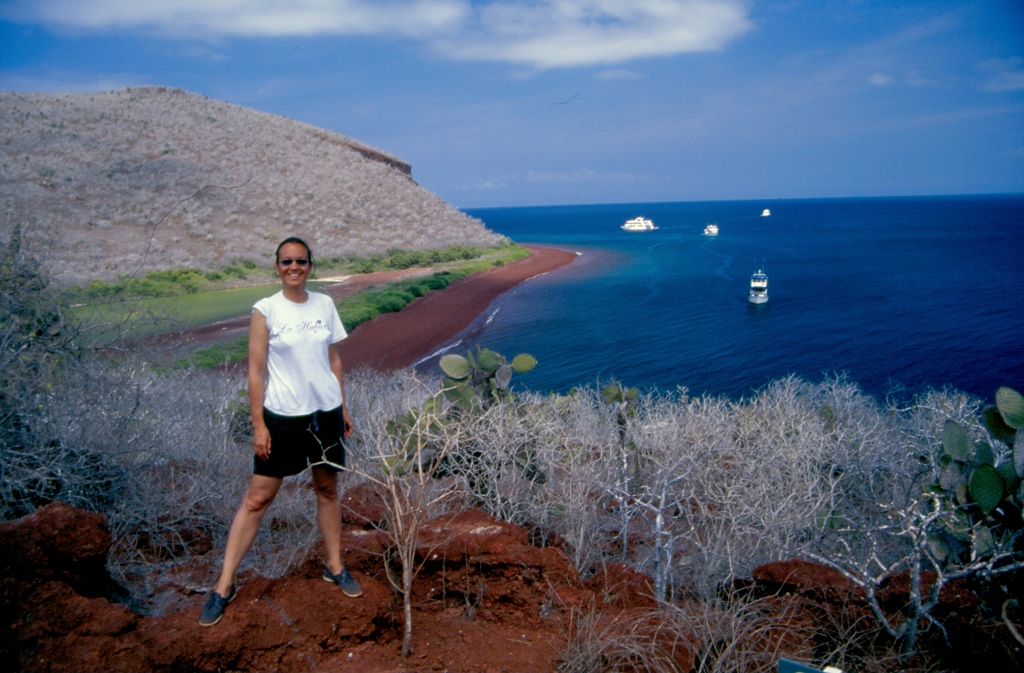 Rabida
Rabida
After Rabida, we went to a strait between the island Sombrero Chino (Chinese hat), which looks exactly as its name suggests, and the island Santiago. The ocean is not very deep there and the bottom is covered by sand, which meant that the colour was luring. I bravely responded by diving in, but I didn’t stay in the water for too long, as it was quite cold, completely contrary to my expectations based on the turquoise-greenish clear water usually associated with tropics and heat. No wonder than that a little while later we paid a visit to a rock that held a few penguins!!! These were small Humboldt penguins and the Galapagos is the most northern point reached by the penguin population. Talking about Humboldt, it is precisely thanks to the cold current named after him that the waters around the Galapagos, despite the proximity of the equator and the tropics at that latitude, are not really warm, but rather quite chilly. While we were sitting in the dinghy, the engine of which hummed quietly lest it should disturb the penguins, one of them floated to us and peered at us probably to see what sort we were. I don’t know its conclusion, but soon it dived in and got lost in the water, while we went to Sombrero Chino for a brief walk there. In addition to seeing animals that had by now become all too familiar, it was interesting to see the beach we landed on that was covered in pieces of broken white corals. As Cesar told us, this was again caused by El Niño some 7 or 8 years before.
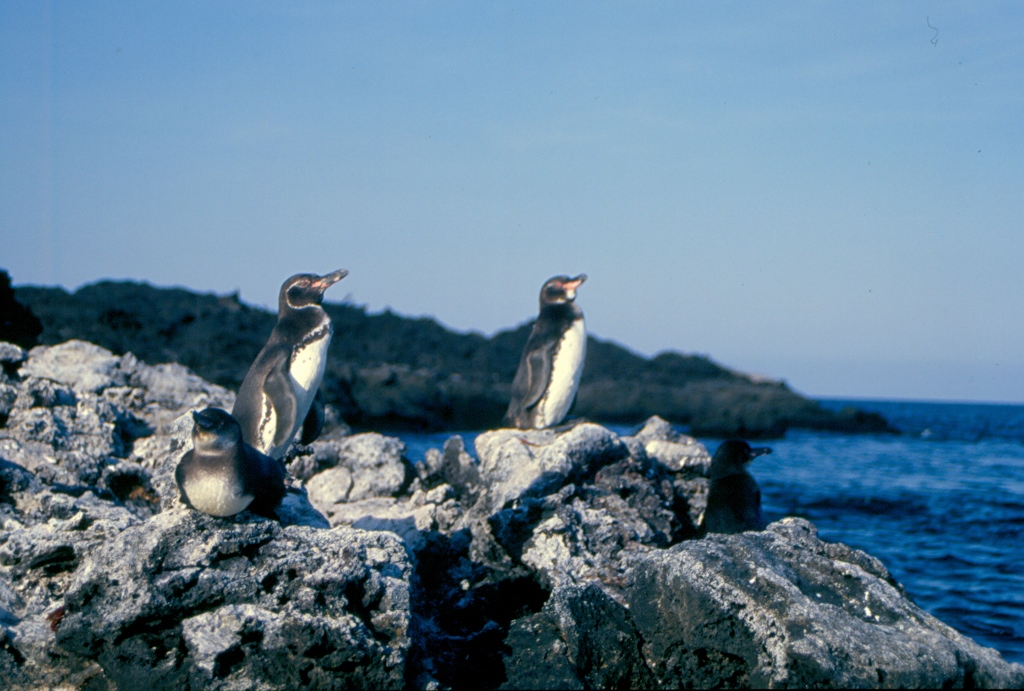 Humboldt penguins
Humboldt penguins
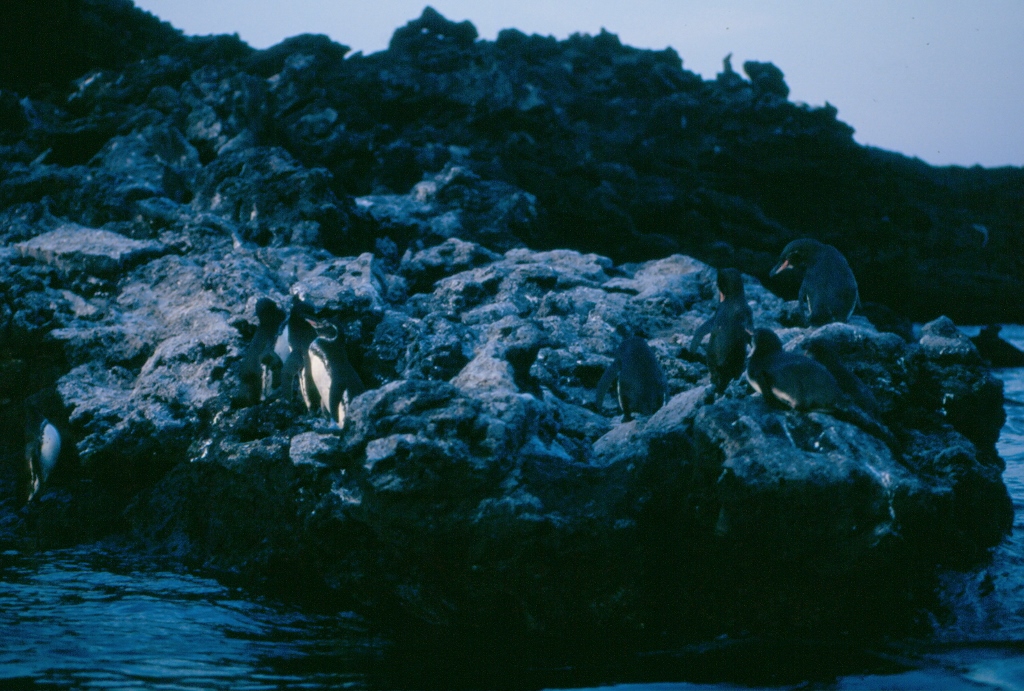 Humboldt penguins
Humboldt penguins
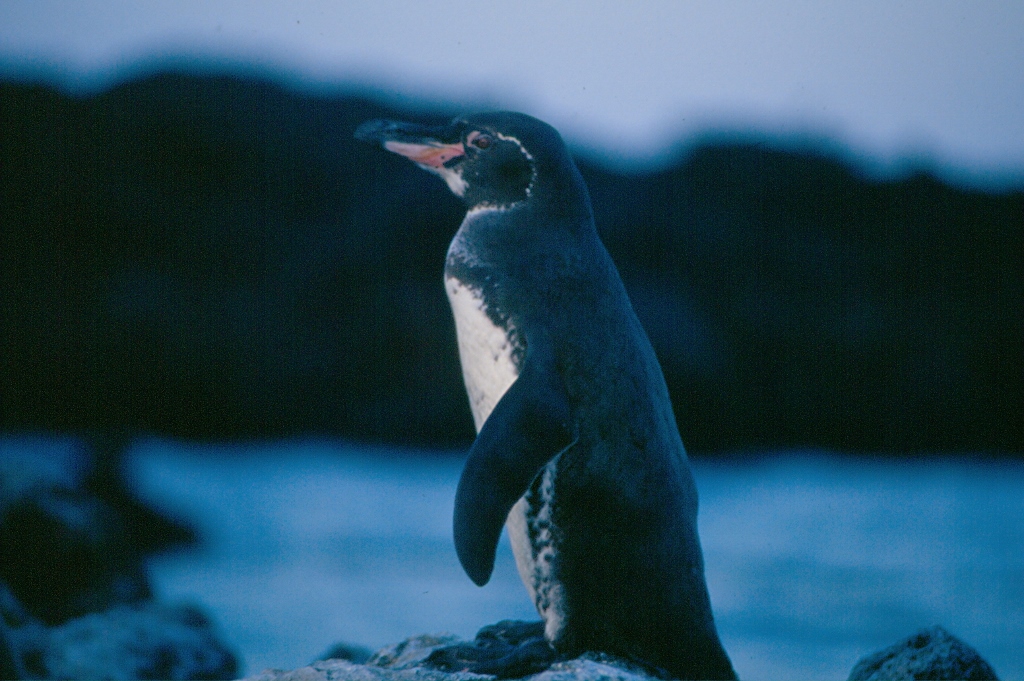 Humboldt penguin
Humboldt penguin
In the evening we had a little celebration or rather – a surprise party! Janet had her birthday the following day and a couple of days earlier her husband who didn’t speak Spanish had asked me to see with Alfredo if he could come up with some cake so that we could all throw a surprise party on the eve of her birthday. And so it happened, the cake was simple, yet delicious, and the company was merry. Milton went lobster hunting again with Marco in order to have special menu for the birthday with Ecuadorian lobster specialties, but he came back with the dinghy almost completely full of lobsters, which meant that we had them both for lunch and dinner. I was too busy eating to complain.
The following morning I got up, like I did every morning during the trip, just before sunrise, but this time it was Milton who woke me up to see something special. We were very close to the top of a volcano whose entire crater protruded out of the ocean. In one section, the height of the crater was the same as the ship’s, so Milton got the vessel as close to the volcano as possible. Inside the crater, there was a lake surrounded by a wreath of greenery and in the lake there was a flock of flamingos. Ah! If only I could wake to such images more often.
Then we had to continue and soon the whole company was awake and up. That captain Milton was indeed a good guy. He let one of the passengers steer the ship for a little while. The ocean was calm, there was nothing around us and the newly appointed “captain” was standing proudly by the steering-wheel. He was to follow the sun, said Milton, who went to have a rest. At one point Carlos rushed in breathlessly asking what was going on since Alfredo’s dishes were flying all over the kitchen. Later I found out that one of my friends was taking a shower at the time and she also had trouble standing straight, but everything calmed down when Milton came back.
The end of our journey was getting dangerously close and nobody was happy about it, but there was no choice. We could only give in and continue to enjoy. On the penultimate day we went to a small, but very interesting island Bartolome and anchored there. Still, we first went by the dinghy to a bigger island Santiago that is right across from Bartolome in order to see cooled lava that got to the surface around 130 years before during the last major eruption of a volcano on the island. On that occasion, the actual surface of the island increased, as the lava flowed into the ocean wrapping a couple of large rocks and adding them to the size of the fourth largest island of the Galapagos (its official name is San Salvador). There we could see the first signs of life appearing on the surface of the solid lava in the form of low and small cacti and the whole area appeared as if walking on the Moon or at least I imagine it to be like that. This is also a good place to see the main mark of Bartolome. This is a huge rock called the Tower that leans even more than the one in Pisa, but this is not a natural phenomenon. During WWII, the Americans stayed on Baltra and set up their base there in order to control this part of the Pacific. At some point, some idle solders did some shooting tests and thus they hit right across the middle of a hill on Bartolome, leaving one side of it in the shape of leaning rock tower. From an elevation on the other side of the tiny island it is possible to enjoy one of the most popular views of the archipelago – two bays of Bartolome that seem to make a curve reminiscent of a sand-clock, the Tower and Santiago in the background with its strange and out of this world appearance. Afterwards we got down to the beach for a farewell swim, but an even bigger attraction awaited us on the other side of the sand dunes that stretch over the “sand-clock curve.” The water was significantly warmer there, but also murkier. There I came across some 5 or 6 white-tip sharks that patrolled the shallows. In order to see them better and take photos, I got into the water up to my thighs, but they continued to swim peacefully and pass a meter away from me. I wonder why none of us bathed at that beach. I guess because of the murky water.
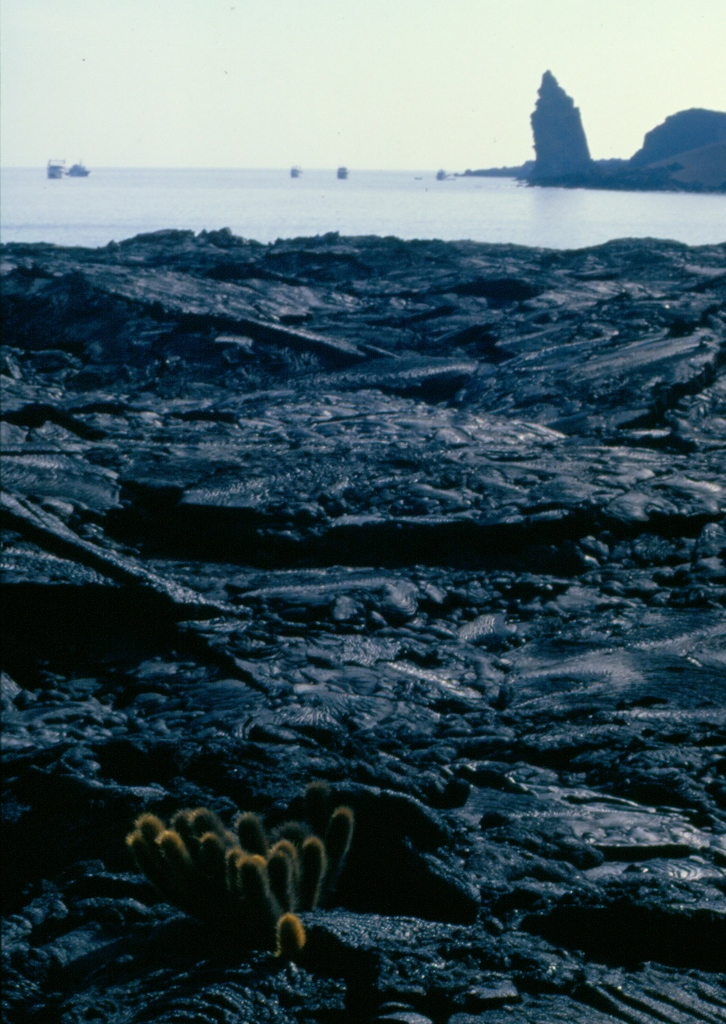 Life on lava
Life on lava
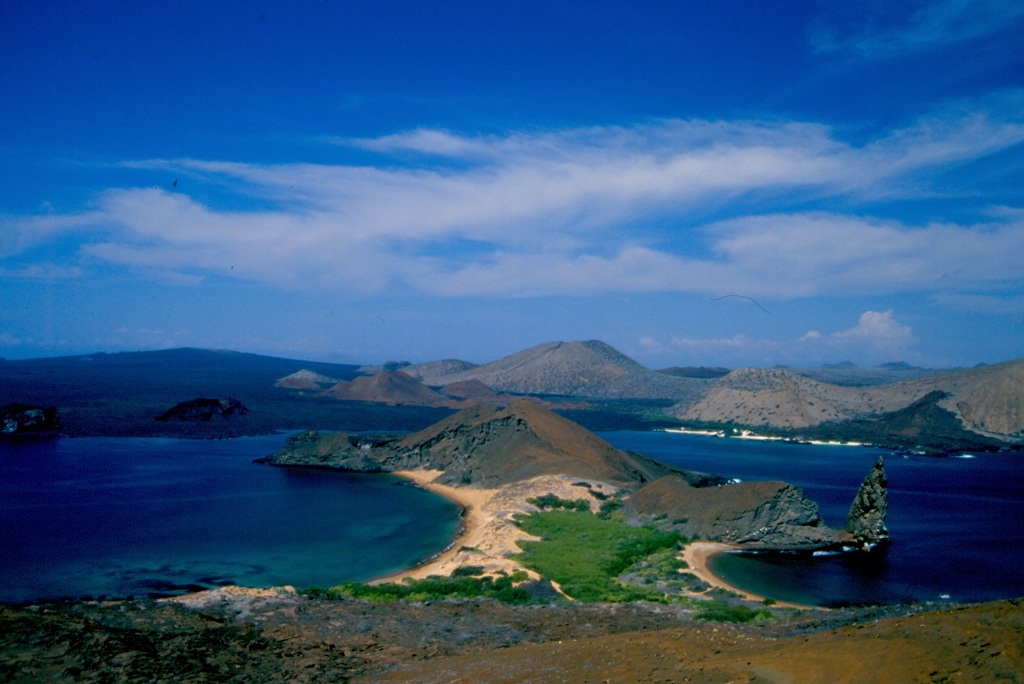 Islands Bartolome and Santiago
Islands Bartolome and Santiago
After swimming and snorkelling for a little while more (on the clear-water side) and looking at different fish and later at peaceful marine creatures resting on the beach, we had to go back to the ship since we had to cover a significant stretch of the ocean till we reached a strait between the islands North Seymour and Baltra. We spent the night there and as a parting gift to take home with us in the form of a memory, we were taken for a walk on North Seymour before sunrise. There we were greeted by an entire colony of frigatebirds. There were blue-footed boobies, that are always charming and fun, there were swallow-tail gulls, but they all paled in comparison to male frigatebirds in the middle of their courting. Frigatebirds are black predator birds. They appear simple, inconspicuous, but only until the male decides to show off. He does that in an exceptionally attractive manner: he has a small pouch under his beak which he then inflates into a balloon ready to burst. And the balloon is of bright red. And so you walk around and there are black frigatebirds with stunningly beautiful red balloons perched on low vegetation like decoration on a Christmas tree. And this, indeed, is the perfect picture to be taken from here.
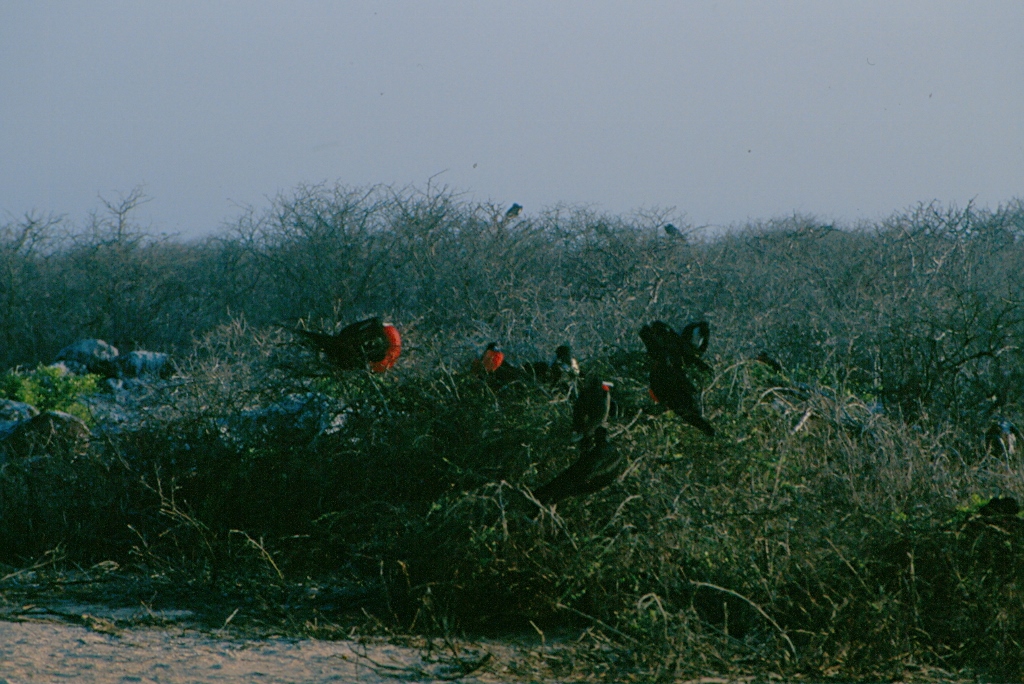 Frigatebirds
Frigatebirds
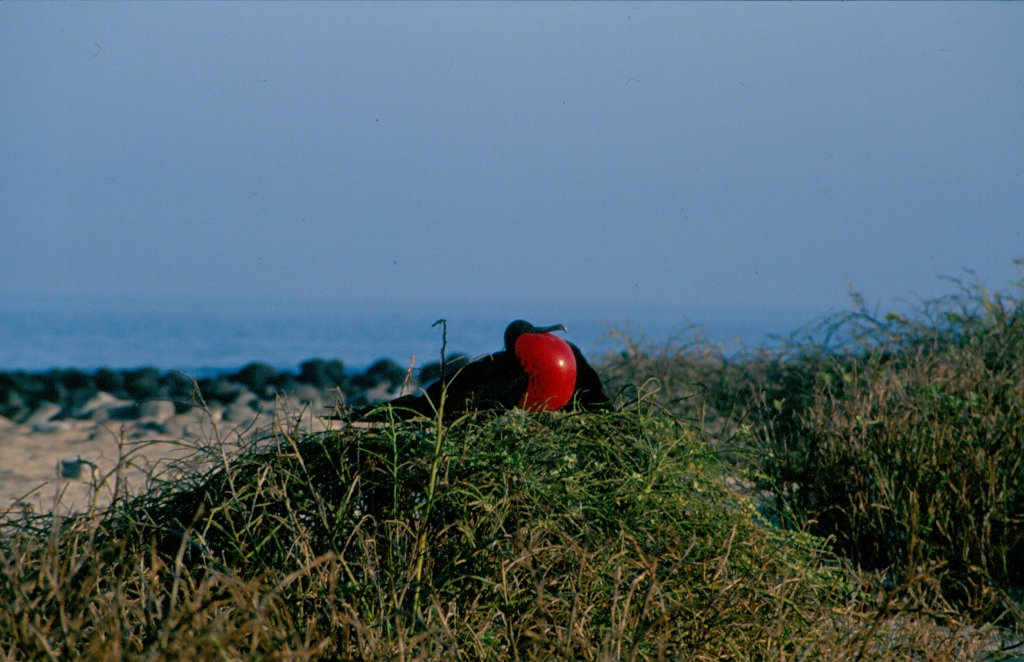 Frigatebirds
Frigatebirds
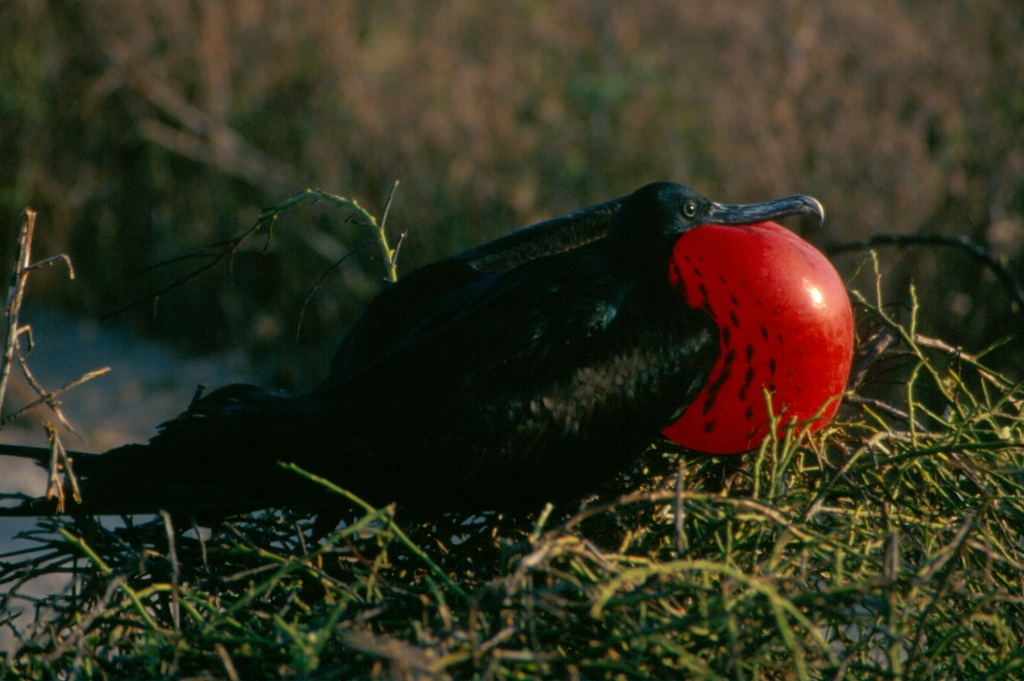 Frigatebird
Frigatebird
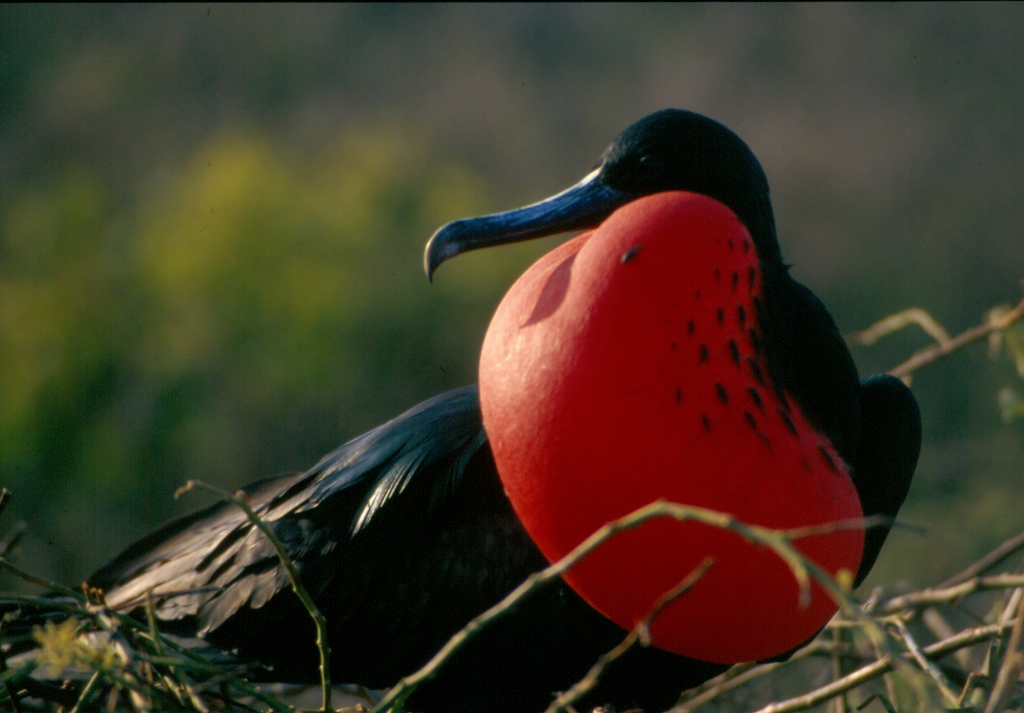 Frigatebird
Frigatebird
Yet, I hope that this was the end of only my first visit to the Galapagos. There is so much more to see and there is a special biological calendar which shows by months what is dominant at which point in time during the natural annual cycle of different animals. And, to tell the truth, I wouldn’t mind even doing the same things I did this time. Hopefully it will be so.